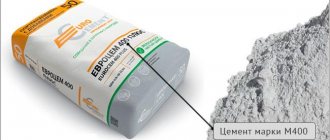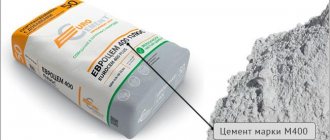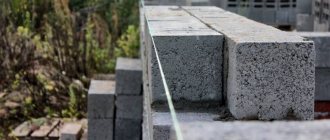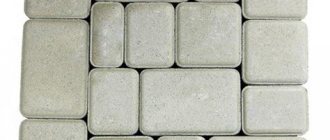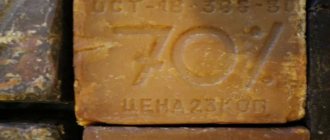Cinder block laying.
Laying cinder blocks is a good solution for many construction works due to its comparative simplicity and low cost.
Cinder block beats brick in cost, as well as in the speed of laying, thanks to its four times larger size, despite the fact that work with both materials is carried out in a similar way. First, let's briefly tell you what a cinder block is. Cinder block is an artificial building material in the form of a brick with dimensions of 400x200x200, made from cement and filler. Despite the name, the filler is not necessarily slag - crushed stone, sand, gravel, and other materials can be used as it.
When building walls, cinder blocks are laid on a ready-made foundation. The procedure here is quite simple:
- a solution is laid on the foundation;
- he is leveled;
- place a cinder block (hold it in the middle with your left hand);
- align along the stretched cord, tapping the cinder block with a trowel;
- remove excess mortar from the cracks using a trowel;
- align the finished row in a manner similar to the alignment of individual blocks;
- starting the next row from the corner, in order to move it, put half a cinder block (the stone can be divided with a hacksaw or a circular saw).
The thickness of the seams should not exceed 1.5 cm, otherwise the thermal insulation of the masonry will be compromised.
Slag concrete - composition and proportions
The name of the material is determined by the presence in its composition of fuel slag or waste from the metallurgical industry. The grain size of the slag ranges from 2.5 mm to 8 mm. Slag dust is also used for better adhesion of materials. The grains are sifted out using a sieve. Dust masses are sifted in the same way.
Thanks to the lightness and porosity of the filler, the structure is lightweight and has increased thermal insulation properties.
Before adding to the solution, the slag must be moistened with water. This is due to the high porosity of the material. If the slag is dry, it will adhere less well to the concrete, leaving pores filled with air. Such design flaws will reduce its strength. It takes almost 80 liters of water to wet 1m3 of slag product. If the slag is wetted by rain, additional wetting is not necessary.
Cinder concrete also contains lime. It can be slaked or not slaked. Slaked lime must be diluted with water to the consistency of milk before adding to the solution. The mass of lime is 1/3 of the volume of slag products. For greater strength, 2/3 clay is added to the solution. This composition takes longer to gain strength, but its strength characteristics increase.
The water used to dilute the mixture must be free of organic impurities. The chemical composition of water, with unacceptable impurities, can react with other components, leading to undesirable consequences. Water consumption per 1m3 of slag concrete is approximately 200 liters. This amount includes the liquid with which the lime is diluted and the water added to the slag.
The grade of cement is determined by the operation of the structure and the requirements for it. The dose of cement in the solution is 2/3 of the volumetric weight of the slag.
Glue consumption for foam blocks/gas blocks per 1 m3/m2
Glue consumption, as a rule, depends on several factors, among which we will highlight:
- use of specially designed tools during work. The fact is that improvisation in this matter is not entirely appropriate,
- master's qualification. Everything here is quite simple: the higher the level of skill, the more optimal the consumption of the adhesive composition during the work process will be,
- block geometry. If they are NOT the same size in a batch, then the glue consumption in this case will increase significantly.
- thickness of the layer applied to the working surface. Naturally, there is no need to specifically measure this indicator, but, nevertheless, it should not exceed 3 mm. Of course, if this figure is exceeded, nothing terrible will happen, but it will significantly increase the consumption of material. And 2–3 mm will be quite enough for reliable adhesion of the elements to each other.
If for construction you have chosen products that were made using German technology (for example, WEHRHAHN, YUTONG, HEBEL), the website of these companies must contain information about which glue is best to use for gas blocks/foam blocks, how to prepare it correctly and what kind of glue it is quantity needed for 1 m³/1 m².
The glue consumption rate per 1 m2 is approximately 1.5–1.6 kg of dry powder with an applied thickness of 1 mm, therefore, 15–30 kg will be consumed per 1 m³. As we can see, the numbers are approximate, since it is almost impossible to give an exact figure for how much glue is needed per foam block cube. But we will allow ourselves to average the indicators - and name a certain weight - 25 kg. This is exactly the weight of one bag of adhesive composition. Knowing this, it will be easy for moms to calculate how much glue is needed to build the masonry. And for greater convenience, we present to your attention a small list below:
- per 1 m² - ≈1.5 kg,
- per 1 m³ - ≈25 kg (one bag).
Now let's look at a specific example. For example, to erect a building you will need 55 m³. Let's assume that all the blocks are in perfect condition, and their sizes do not differ from each other by even a millimeter. Now we just need to multiply the weight of the glue by the number of cubic meters. As a result, we obtain the following calculations:
- 25 (kg/m³)×55 (m³)=1375 (kg of dry adhesive composition).
And since the glue is sold in craft bags of 25 kg, let’s calculate their quantity:
Therefore, we will need 55 craft bags. Although, if we proceed from the calculation that one package will be used per 1 m³, there is no particular practical meaning in these calculations. But they are given purely as an example.
Calculation of the number of foam blocks
Having decided on the dimensions, we will calculate how many foam blocks are needed for a one-story house, for example, 150 sq. m. size 10x15 and height 2.8 m with one internal load-bearing and two non-load-bearing walls. Let us assume that there will be one entrance door measuring 0.9x2 m, 4 windows measuring 1420x1460 mm each, 2 internal doors for a load-bearing wall measuring 0.8x2 m.
As we have already determined, for external walls we use foam blocks of size 200x300x600 mm, for the internal load-bearing wall we can use blocks 200 mm thick (you can use the same blocks, but install them on the short side), and for partitions we use blocks of size 100x300x600 mm.
So, let's determine how much for a house with an area of 150 square meters. meters you need foam blocks:
- It is necessary to calculate the perimeter of the house: 2 walls of 10 and 2 of 15 meters give a total of 50.
- Now you need to calculate the area: multiply 50 m by a height of 2.8 m - we get 140 sq. m.
- We add an internal load-bearing wall, reducing its length by the total thickness of the two external walls: 10 m - 0.6 m = 9.4 m, its area is 26.3 square meters. m. The total area of the five walls is 166.3 square meters. m.
- We calculate the area of the front door - 1.8 sq.m. Window area – 8.3 sq. m, and the area of the internal doors is 3.2 square.
- The total area of the load-bearing walls of the building, including doors and windows, is 153 square meters. m.
- We calculate the area of foam blocks for external walls: 0.2 m * 0.6 m = 0.12 sq. m.
Now we have everything to calculate how much is needed for a house of 150 sq. m. meters of foam blocks: 153/0.12=1275 pcs. If you convert this into cubic meters, you get the value 1275 * 0.036 (volume of one foam block) = 50 m3.
This does not take into account the gaps between the blocks for mortar or glue. The technology for installing walls made of foam blocks is not included in the topic of the article, but given the accuracy of their geometric dimensions, glue should be used instead of traditional mortar.
The smaller the gaps, the better, since they are good “bridges” for the penetration of cold into the house, so the thickness of the seams of a few millimeters can be neglected.
It is necessary to purchase foam blocks with some reserve, taking into account their possible damage during transportation or construction.
We showed an algorithm for calculating how many foam blocks are needed for a house planned for construction. We offer to calculate their number for internal walls, partitions or for the second floor yourself, or you can use online calculators. How many foam blocks are needed for a house of 100 square meters? m., with different sizes and numbers of windows, doors, internal walls, floors? The calculation is done in the same way, and do not forget that it is better if a few blocks remain rather than running out before the construction of the walls of the house is completed.
You can calculate the required amount of building materials in a slightly different way. Counting their number in one row along the entire perimeter, then determining the number of rows and multiplying the two values to find the result. The resulting number of blocks can be converted into area, reduced by the size of windows and doors. The result should be the same.
Necessary components for preparation
The classic mortar for laying cinder blocks consists of three components:
Sand . It must be clean, without foreign impurities that will lead to the formation of lumps. Sand must be purchased at the store.
You can make a choice in favor of class II river or quarry sand, or a mixture of both. The grains of sand in it are small, so the adhesion to the surface will be strong.
- Cement . The choice should be made in favor of Portland cement, which is a hydraulic binder based on gypsum, cement clinker and additives. Its brand must be no lower than M400 or M500.
- Water . It must be clean, without silt or mold, which can impair the quality of the adhesion of the solution and provoke the destruction of the structure. There should be no excess or deficiency of minerals in the water.
What is the consumption of mortar per cube of masonry blocks?
To lay one cube, you will need approximately 0.15–0.2 cubes of cement-sand mixture prepared in proportions 1:4. In other words, 350 (kg cement)×0.15=50 (kg). Or 350×0.2=70 (kg).
After these calculations, all that remains is to multiply: the volume of the masonry blocks themselves x the volume of cement x the cost of cement (one kilogram). But you can also divide the indicator by 50, and then multiply by the cost of one bag of cement. At the same time, do not forget to include the cost of sand in your calculations.
Here, in fact, is all the information you need when making calculations. Now let's talk about the direct work associated with the construction of walls.
Laying cinder block
Cinder block is, in fact, one of those materials that does not have a clearly regulated composition, because it uses both a standard set of water and cement, and free additives in the form of waste from already used materials, which can vary greatly - slag, shell rock , construction screening and much more. It is the quantity and quality of this additive that will ultimately show the quality of the cinder block. Its standard dimensions are 190*188*39 mm.
Scheme of cinder block molding.
Cinder block is different from all others, and the proportions of the cement mortar are unique to it. So, to prepare the solution, a ratio of 8 to 1 by weight is used (8 cement and 1 sand), and as much water as required. Thus, the strength of the solution increases significantly. But for laying cinder blocks, a stable figure of 23% + – 2 is used. Thus, 200-250 liters of cement will be required per cube. If the grade of cement is very low (less than 100), then 23% can be changed to 27%, because otherwise the result will be quite fragile.
The use of blocks can seriously increase the thermal capacity of walls, as well as speed up the construction process, because they are inherently larger than their closest competitor. But cinder block also has its disadvantages, namely fragility. It is undesirable to use force on it once again, because you can just break it.
General information on the calculation results
— The total length of all walls taken into account in the calculations.
About the total area of masonry
— The area of the outer side of the walls. Corresponds to the area of the required insulation, if provided for by the project.
Wall thickness
— The thickness of the finished wall, taking into account the thickness of the mortar joint. May differ slightly from the final result depending on the type of masonry.
Number of blocks
— The total number of blocks required to build walls according to the given parameters
About the total weight of the blocks
— Weight excluding mortar and masonry mesh. Just like the total volume, it is necessary to select a delivery option.
Amount of mortar for the entire masonry
— The volume of mortar required to lay all the blocks. The volumetric weight of the solution may vary depending on the ratio of components and additives introduced.
Number of rows of blocks including seams
— Depends on the height of the walls, the size of the material used and the thickness of the masonry mortar. Excluding gables.
Quantity of masonry mesh
— The required amount of masonry mesh in meters. Used to reinforce masonry, increasing solidity and overall strength of the structure
Pay attention to the number of reinforced rows; by default, the reinforcement of each row is indicated
Approximate weight of finished walls
— Weight of finished walls, taking into account all building blocks, mortar and masonry mesh, but excluding the weight of insulation and cladding. — Load without taking into account the weight of the roof and ceilings. This parameter is necessary to select the strength characteristics of the foundation.
To calculate the material for partitions, you need to start a new calculation and indicate the length of only all partitions, the thickness of the walls to the floor of the block, as well as other necessary parameters.
Foam blocks are a widespread building material among citizens of our country for the construction of private houses, garages, sheds and other buildings.
Before purchasing foam blocks, you need to accurately calculate how many pieces you will need for construction. This will reduce unnecessary costs and also protect you from purchasing additional blocks during the construction process.
How much cement is needed to lay a cube of blocks?
Now it remains to calculate the cost of masonry mortar (the cost of cement for masonry mortar) for the entire volume of masonry for the house. To do this, you need to figure out: how much mortar is needed to lay one cube of blocks?
For laying a cube of blocks, an average of 0.15 - 0.20 cubic meters of masonry cement-sand mortar 1:4 or 350 kg of cement x 0.15 (0.2) = 52 (70) kg is used. cement for laying cube blocks. Plus sand.
Now all that remains is to multiply 1). volume of blocks in cubes for laying the walls of your house by 2). the volume of cement is 52 (70) kg for laying a cube of blocks and 3) the cost of 1 kg of cement (or first divide by 50 and multiply by the cost of a bag of cement). And don't forget about the sand!
Now you have all the information to make a decision: which mortar to use for laying the blocks: adhesive or cement-sand.
Subscribe to the FREE BONUS “Eight practical techniques that must be used when laying walls from blocks”, laying walls from gas silicate blocks, provided you follow certain rules and know the secrets of masonry, will not present any difficulties for you.
See you soon on the pages of the blog “How to build a house”!
Let's sum it up
Now let's put everything together that we thought earlier:
- To begin with, let us remember that our house will require 1800 blocks (+/- an error of 100 stones) and about 55,000 rubles will be spent on this matter.
- Now the solution, as we found out, we need almost 4000 kg of cement. Of this, 2,500 rubles will be spent on sand (add delivery here), and a little more than 44,000 rubles will be spent on cement in bags. You can also add transportation costs here and, as a result, the total cost will be equal to 50,000 rubles.
- As for the tools, this is a matter for each individual; you don’t have to buy a concrete mixer and mix the solution with your own hands. It will, of course, take longer, but it will also be cheaper.
Agree, spending a little over a hundred thousand on cinder block masonry is not that much. If you compare brickwork, the figure will be much higher. We tried to give prices that are optimal for most central regions, so if you get a different amount, it will not differ much.
How many cinder blocks are there in a cubic meter?
The number of blocks per cubic meter can be calculated using simple mathematical formulas. Do the following:
- Product dimensions are usually indicated in millimeters - convert them to meters. For example, the dimensions of a block of 390x190x190 mm after translation will look like 0.39x0.19x0.19 m. This action must be done for the convenience of further calculations;
- multiply the length, width and height of the product - you will get the volume of one piece in cubic meters;
- divide 1 cu. m by the resulting value.
As a result of such simple calculations, you will find out how many blocks you have chosen for construction will contain one cube of masonry.
For insurance, you should increase the resulting figure by 5-10% to take into account defects.
Types of masonry
There are several ways to lay cinder blocks. They can be laid:
- in one stone; one and a half stones; spoon method (using half the stone); two stones.
Masonry thickness
To determine the thickness of the masonry, it is necessary to analyze how many degrees the air temperature drops in a given area. If the winter is warm, then a thickness of 45 cm is sufficient to build a house; in northern latitudes, the thickness of the walls should be at least 60 cm.
